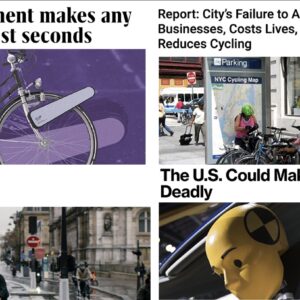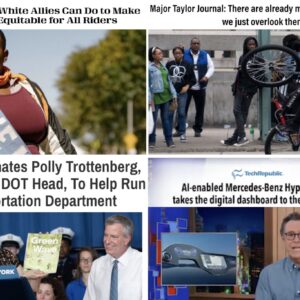“Evidence suggests that having more cyclists on the road decreases the proportion who are involved in accidents, so more people taking up cycling makes it safer. Introducing a measure which is guaranteed both to get more people on bikes and make sure drivers understand cycling is a no-brainer.”
— Tom Richards,
The Guardian
Here’s the news and other interesting stuff that caught our eyes this past week…
– Mayor Rahm Emanuel has renewed his promise to make Chicago the “bike friendliest city in the country” by installing hundreds of miles of new bike lanes including at least one lane with bicycle-specific traffic signals.
– Even if drivers’ tests include questions about laws pertaining to bicycles, a blogger for the Guardian newspaper in the UK thinks the best way to make people aware of bicycle traffic might be to include a mandatory cycling test as part of drivers’ licensing exams.
– The number of people walking who get killed in motor vehicle-related crashes is on the rise and both vehicle manufacturers and the National Highway Traffic Safety Administration think changes to vehicle design and advances in collision avoidance technology will help turn the tide.
– A report from Transportation Alternatives finds that most people who die while walking or riding a bike are killed by people who break the law while driving.
– It turns out there are a few bicycle components on Mars – sort of. A team from LiteSpeed Bicycles, based in Chattanooga, TN, worked with Jet Propulsion Lab engineers for a year to develop the framework and other components of NASA’s Curiosity rover.
– The New York Times‘ Jonathan Vaughters takes on a controversial issue and discusses how we might get doping out of sports.
– Jay Ruiz is helping protect late-night travelers in New York City with the Brooklyn Bike Patrol, a volunteer organization that will escort people home at night that’s gained attention and praise from news outlets, churches, the Brooklyn borough president, and even a New York senator.
– If you’re someone who learned to ride a bike later in life (or even if you’ve been riding since you were a kid) you’ll enjoy this rather entertaining story from the NY Times‘ transportation reporter Matt Flegenheimer on his recent experience learning to ride a bike as an adult in New York City.
– There are many great places to ride all across the United States and Bicycling has a list of the best bike ride in all 50 states. (You’ll have to read it yourself to find out Oregon’s, but I’ll give you a hint: it’s on the route for this year’s 25th-anniversary Cycle Oregon.)
– A man has died after his bicycle wheel got caught in an abandoned stretch of streetcar tracks in Toronto, Canada.
– Gold-medal-winning cyclist Joana Roswell discusses how riding a bike helped her find confidence as a teenager after growing up with alopecia.
– Bicycling takes a look at Los Angeles’ relatively new anti-harrassment law that’s already inspired other jurisdictions to better protect people on bikes.
– The intersection of bicycles and fashion has hit the mainstream in Vogue’s list of “pre-fall looks” that match stylish bicycles.
– Employees of the popular craft marketplace Etsy are taking recycling into their own hands by transporting over 600lbs of compostable waste to a local farm by cargo bike each month.
– There’s a fun look at Portland’s recent Cago Bike Roll Call from Seattle’s Davey Oil.
– And here’s a few photos of an odd sight: cruiser bicycles on display in a BMW showroom.
– A video from Portland’s Chris King Components highlights the beautiful scenery and delicious food of the Gourmet Century:
– And finally, Street Films found evidence of a ciclovia in Los Angeles way back in 1979:
— Did you find something interesting that should be in next week’s Monday Roundup? Drop us a line. For more great links from around the web, follow us on Twitter @BikePortland.





NASA’s Curiosity rover:
If I wanted to put a 1 ton mobile research lab on another planet I sure as heck wouldn’t let automotive designers come up with the plans for the vehicle. I would only have 200 pounds left for test equipment after the vehicle net weight.
I wouldn’t be so sure of that. Auto manufacturers have the ability to engineer light things, too. It seems they don’t primarily because they pander to consumer’s wishes and safety regulations. The same things don’t quite apply to something like the Curiosity rover, though.
Ability perhaps but not the mindset.
No matter how high oil prices go they are still intent on designing vehicles from the “lizard brain” perspective.
Ability means nothing if the auto industry doesn’t have the will to force themselves to think outside of the box that any four wheeled vehicle must be an overpowered suit of armor.
If I had to choose a vehicle designer that needed to be at one with the concept of light weight efficient design I would go with the one that is used to making vehicles for human power and not the one that is acclimated to the profligate waste of 200 horsepower to achieve the same basic goal.
“…because they pander to consumer’s wishes…” Caleb
Do you have in mind, an alternative, legitimate means of persuading customers to trade their money for auto manufacturers products? In the few pictures I’ve seen of it, Curiosity, the Mars mobile terrain space lab, with it’s lightweight frame and wide oval web tires, is a cool vehicle.
Down here on planet earth, people in the U.S. haven’t tended to be big on dinky, flimsy motor vehicles. There are exceptions of course, more recently, cars like the Chevy Metro of some years back, and now, the Smart and the Fiat 500.
Much more commonly, people in the U.S. seem to love opening their wallet for big behemoths like the Chevy Suburban, that apparently can literally be driven at speed into a telephone pole, shearing it off, to leave it hanging from its wires, the person behind the wheel escaping with their life, proceeding after the collision to get out of the vehicle and run around naked on the highway like a crazy person (re; oregonian story from this weekend.).
> The number of people walking who get killed in motor vehicle-related crashes is on the rise and both vehicle manufacturers and the National Highway Traffic Safety Administration think changes to vehicle design and advances in collision avoidance technology will help turn the tide.
You know what would actually turn the tide? Holding motorists responsible for the deaths they cause. If you aren’t drunk when you kill someone while driving, the chances of you ever being prosecuted are pretty much nonexistent. Strangely enough, if you kill a pedestrian while cycling, you’ll probably be charge with a felony:
http://sfist.com/2012/06/14/cyclist_who_killed_castro_pedestria.php
http://www.streetsblog.org/2012/06/26/nypd-15-pedestrians-one-cyclist-killed-in-new-york-city-traffic-in-may/
That Toronto story could just as easily read:
“- A man has died after crashing his bicycle while not wearing a helmet in Toronto, Canada.”
There are a lot of hazards out there. Streetcar tracks are just one of them.
I’m with Randall. The real problems are driver distraction and a lack of accountability. More nanny systems are just going to encourage ever more driver distraction. Why bother looking for pedestrians if your car is (probably) going to watch out for them for you?
The solution is force people to pay attention and hold them responsible for the consequences of their actions.
First off would be to keep publicizing the dangers, and keep working on building public awareness and support. We’re not there yet. Millions still think using their handheld devices while moving is Ok once in a while … just like millions used to think that about drunk driving.
Occasional distracted-driving stings would help a lot and would be really EASY for cops to do. On a recent afternoon ride across the Ross Island Bridge, car traffic was slow and I made a point of looking at the drivers and seeing if they were paying attention. Most were, but a number appeared to not be fully engaged, and I counted four drivers who were looking at handheld devices while their vehicle was moving. One guy was even holding it against the top of the steering wheel so he didn’t have to move his eyes too much to glance at the road.
Busting people for this would be like shooting fish in a barrel. Have a plainclothes cop stationed in a spot where it’s easy to look into vehicles, and calling ahead to a motorcycle or other cop(s) stationed further along — just like cops do when they stage speeding stings. Do this a few times, let word spead and publicize it, and I bet you’d see a significant decline in Distracted Driving (which should be the new “DD” in “MADD”).
Oh, and don’t bust people who are checking their phone while their car is STOPPED at a red light, like Beaverton cops are now doing. It’s technically illegal and easy pickings for the cops, but a victimless violation that doesn’t endanger anyone. Like stinging cyclists who roll through stop signs when no one’s around, it doesn’t do anything for public safety and undermines public support for real enforcement.
you want people to pay attention, remove the windscreen